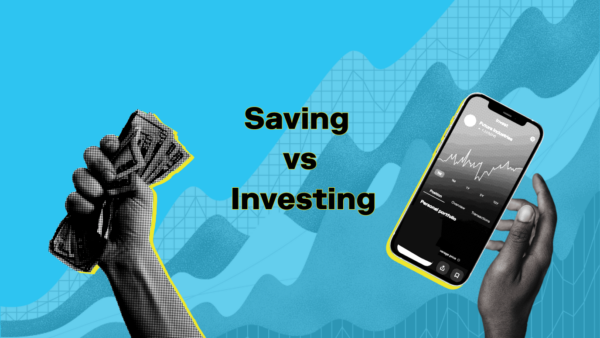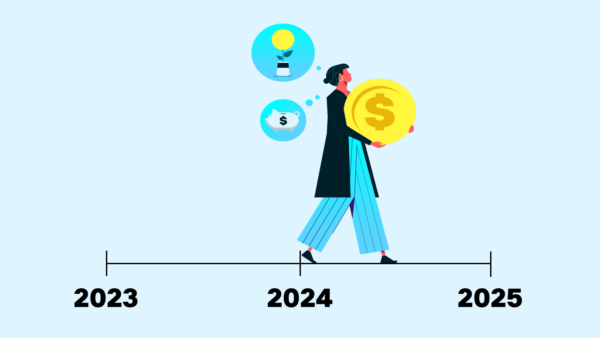Dec 8, 2022
What is Dollar-Cost Averaging (DCA)? A Simple Definition

Dollar cost averaging (DCA) is an investment strategy that allows investors to buy assets over time by investing a set amount of money on a regular basis. Rather than attempting to time the market with a lump sum investment, Dollar-cost averaging is all about building wealth over the long term for things like retirement or large financial goals.
DCA may help reduce the risk of volatility, diversify the average cost of shares, and relieve some of the stress that can come with investing. It may also help you become more disciplined about putting your money to work. While the market goes up and down over time, DCA can keep you steadily building your portfolio with the long view in mind.
In this article, we’ll cover:
- How dollar cost averaging works
- The benefits of DCA
- The downsides of DCA
- Who dollar cost averaging is best for
How does dollar cost averaging work?
The idea behind DCA is simple: you choose a set amount of money to invest at regular intervals over time, such as monthly, bi-weekly, weekly, or even daily. Many people simply set up a recurring transfer from their checking account to their 401(k), IRA, or brokerage account. Every time you put that money into your investment account, you buy more shares of the stocks, funds, or other securities in your portfolio. Because you’re purchasing securities regularly over a long period of time, you’ll automatically buy fewer shares when the prices are high and more when the prices are low. This slow-and-steady investment strategy allows you to spread out your investment purchases over time so the average cost per share is less impacted by market swings. And DCA can help reduce the impact of volatility on your portfolio, too.
You might think of DCA as the opposite of lump-sum investing, where you put a large amount of money into a security all at once. That requires you to time the market in an attempt to buy at the lowest possible cost and then see your investment’s value rise. Timing the market, however, is both difficult and risky. For example, if you attempt to “buy on the dip,” snapping up shares when the price falls, you could easily mistime your investments. And volatility of particular securities, sectors, and the market as a whole can make predictions tricky.
Examples of dollar cost averaging
Because you buy shares on a regular basis over time, DCA diversifies the average cost per share of a security. For example, say you want to invest $2,400 in an exchange-traded fund (ETF) this year, so you put $200 into your investment account on the first day of each month. The amount you invest stays the same every month, but the share price of that ETF will fluctuate over time. Say the fund’s share price is $50 per share on January 1; your $200 allows you to buy four shares ($200 / $50 = 4). If the share price drops to $40 per share when you make your next purchase on February 2, you buy five shares that month ($200 / $40 = 5). You just keep buying $200 worth of shares every month; the actual number of shares you buy will fluctuate along with the share price.
At the end of the year, you’ll have invested a total of $2,400, and the number of shares you own will depend on how the share price has risen and fallen over the course of those 12 months. You can calculate your average cost per share using a formula called the harmonic mean.
Purchasing shares at a steady pace over time tends to smooth out the price you pay for your investment compared to lump-sum investing, and you may wind up owning more shares in the long run. In the example above, if you’d have put all $2,400 into the ETF on January 1 when the price was $50 per share, you wouldn’t have been able to take advantage of purchasing more shares when the cost was lower in February.
Benefits of a dollar cost averaging
Diversifying the average cost per share isn’t the only benefit of dollar cost averaging. Because DCA is an automated, disciplined, incremental investment strategy, it can help remove the emotion often associated with investing and allow you to start investing with whatever amount of money you can afford now instead of waiting until you have a large lump sum. It can also help reduce the risks associated with share price volatility and attempting to time the market.
Key benefits of dollar cost averaging:
- Mitigates the investment risk associated with market mistiming
- Reduces the impact of share price volatility by diversifying the price per share
- Makes investing more straightforward with a fixed, automated investment schedule
- Allows you to start investing sooner with an amount that fits your current budget
- Alleviates the stress that market fluctuations can cause
- Focuses on building wealth over the long term
Disadvantages of dollar cost averaging
Every investment strategy comes with risks or disadvantages, and DCA is no exception. As opposed to lump-sum investing, dollar cost averaging includes what experts call the cash drag, or the amount of time investors hold onto money instead of putting it into the market where it could earn a return. Due to inflation, that uninvested money can lose value over time. Additionally, some people argue that DCA has the same risks as a lump-sum investing strategy, just at a later time.
Key downsides of dollar cost averaging:
- You may miss out on returns if you hold onto cash instead of investing it
- You might not be able to invest in higher-price-per-share securities if your brokerage doesn’t offer fractional shares
- It may simply defer the overall risk of investing instead of reducing it
- It may provide lower average returns than lump sum investing in the short term
Who is dollar cost averaging for?
Like any investment strategy, DCA might not be the right choice for everyone. Consider your existing relationship with investing and how comfortable you are with risk. If you have the funds and risk tolerance to take a chance on a lump sum investment or want to actively manage your investments in the hopes of short-term gains, DCA may not support your goals.
But for many investors, DCA offers an accessible way to start putting their money to work for their long-term goals. Dollar-cost averaging can be appealing to people who are hesitant about investing, don’t have room in their budgets to invest a lot of money at first, are just getting started with investing, or prefer to take a hands-off approach to managing their portfolios.
Panicky investors
All investing involves risk, and it’s natural for people to worry about losing money. If the idea of investing makes you nervous, you may be tempted to hold off until you feel the timing is just right, especially during a declining market or potential recession. But sitting on your cash means you could miss out on the gains you could have made by investing. And on the flip side, selling off assets in a panic if the market dips means you lose the opportunity for your investments to regain value when the market eventually rises again.
DCA removes the stress of trying to time the market. Panicky investors may find that a fixed, automated investment schedule helps them remove the emotion from investing. And they might feel more confident riding out market ups and downs knowing that the average cost of shares tends to be smoothed out by DCA, even when share prices are volatile.
Investors with less money to invest
If investing seems out of reach because you don’t have a large lump sum to start with, DCA can make it more accessible to get started. If you’re saving for retirement, for example, there’s no IRS-mandated minimum for contributing to an IRA or standard 401(k). And if you want to invest in stocks or funds through a brokerage, many offer fractional shares that allow you to put your money to work without having to purchase a full share of a specific security.
Plus, the regular investment schedule of a DCA investing strategy ensures that investors with less money stay invested even during a bear market, which can mitigate the risk of missing future growth.
Beginner investors
If you’re just starting out, it can be overwhelming to learn the ins and outs of the market and develop an investing strategy. DCA saves you the stress and risk of attempting to figure out the right time to invest. Plus, the practice of investing on a regular cadence can help you build healthy investing and saving habits. Dollar cost averaging can be a smart way to dip your toe into investing while you gain confidence and learn about additional strategies that may fit your investment profile.
“Set it and forget it” investors
While some people are eager to research investment strategies, watch market performance closely, and actively manage their portfolios, it can become quite time-consuming. For those who just want to put their money to work without spending lots of time and energy, DCA can be a relief. You just need to determine your budget and schedule, then set up regular automatic deposits into the investment account of your choice. Dollar cost averaging keeps you in the market consistently with little management required.
Invest regularly for long-term success
The benefits of dollar cost averaging can support a buy-and-hold investing strategy that’s focused on your long-term financial goals. Maintaining a regular investing schedule could help you mitigate the risk of mistiming the market, diversify the average cost of shares over time, and reduce the potential stress of investing. It’s a fundamental part of the Stash Way, our investment philosophy based on investing regularly in a diverse portfolio for the long term.
With Stash, you can get started with any amount of money and have access to a wide range of stocks and funds with fractional shares. And Auto-Stash makes it easy to stick to your DCA goals with automated investing on the schedule that works for you.
Related Articles

The 12 Largest Cannabis Companies in 2024

Saving vs. Investing: 2 Ways to Reach Your Financial Goals

How To Invest in the S&P 500: A Beginner’s Guide for 2024

Stock Market Holidays 2024

The 2024 Financial Checklist: A Guide to a Confident New Year

How To Plan for Retirement





